
Topics
Guests
- Mark Jacobsonprofessor of civil and environmental engineering at Stanford University and the director of its Atmosphere/Energy Program. Jacobson is also the co-founder of The Solutions Project.
- Noah Diffenbaughsenior fellow at the Stanford Woods Institute for the Environment and an associate professor in environmental Earth system science.
Is a 100 percent renewable energy future possible? According to Stanford professor Mark Jacobson, the answer is yes. Jacobson has developed plans for all 50 states to transform their power infrastructure to rely on wind, water and solar power. This comes as California lawmakers have approved a dozen ambitious environmental and energy bills creating new standards for energy efficiency. Dubbed the California climate leadership package, the 12 bills set high benchmarks for reducing greenhouse gas emissions and petroleum use. We speak with Jacobson and Noah Diffenbaugh, Stanford University associate professor and a senior fellow at the Stanford Woods Institute for the Environment.
Transcript
AMY GOODMAN: Neil Young singing [“Who’s Gonna Stand Up? (And Save the Earth)] This is Democracy Now!, democracynow.org, The War and Peace Report. I’m Amy Goodman. We’re broadcasting from Stanford University here in California. Will it be the climate scientists who save the world? Well, we’ve got two in our studio today. Mark Jacobson is with us, professor of civil and environmental engineering at Stanford University, director of its Atmosphere/Energy Program. Professor Jacobson is also co-founder of The Solutions Project. And that’s what we’re going to talk about next—solutions. Noah Diffenbaugh is also with us, senior fellow at the Stanford Woods Institute for the Environment, associate professor in environmental Earth system science. So let’s go back to April, when California Governor Jerry Brown ordered residents to cut their water use by 25 percent.
GOV. JERRY BROWN: We’re in an historic drought, and that demands unprecedented action. For that reason that I’m issuing an executive order mandating substantial water reduction across our state. As Californians, we have to pull together and save water in every way we can. People should realize we’re in a new era. The idea of your nice little green grass getting lots of water every day, that’s going to be a thing of the past.
AMY GOODMAN: When Governor Brown announced new water restrictions for California, he acknowledged the role of global warming, saying, quote, “The reality is that climate is getting warmer, the weather is getting more extreme and unpredictable, and we have to become more resilient, more efficient, and more innovative.” I want to turn to comments now from President Obama when he visited California last year to announce new federal aid to help the drought-stricken state.
PRESIDENT BARACK OBAMA: Scientists will debate whether a particular storm or drought reflects patterns of climate change, but one thing that is undeniable is that changing temperatures influence drought in at least three ways. Number one, more rain falls in extreme downpours, so more water is lost to runoff than captured for use. Number two, more precipitation in the mountains falls as rain rather than snow, so rivers run dry earlier in the year. Number three, soil and reservoirs lose more water to evaporation year round. What does all this mean? Unless and until we do more to combat carbon pollution that causes climate change, this trend is going to get worse.
AMY GOODMAN: That’s President Obama saying we need to do more. Professor Mark Jacobson, you have just released a state-by-state plan for what needs to be done. What needs to be done?
MARK JACOBSON: Well, our plans are to change the energy infrastructure of each and every state in the United States, and, in fact, ultimately, every country of the world, to infrastructures run entirely on wind, water and solar power for all purposes. So that’s electricity, transportation, heating and cooling and industry. I mean, right now, fossil fuels and nuclear power and biofuels are powering our energy infrastructure for all purposes. And the emissions associated with the burning of the fuels, primarily—burning of fossil fuels and biofuels, in particular—these emissions are causing both air pollution and global warming. And these are almost entirely the cause of both these problems. I mean, air pollution causes four to seven million premature deaths each year worldwide, including about 62,000 in the United States and about 12,000 in California. And global warming, of course, is a growing and rising problem. In terms of costs, the air pollution mortality in the United States alone costs the United States about $500 billion per year, or 3 percent of the GDP of the U.S. And in 2050, it’s estimated that U.S. emissions alone will cause $3.3 trillion of global climate damage, and the rest of the world will cause a total of about $15 to $20 trillion per year of damage. And so, we’re trying to—the only way to solve this problem is to change the energy infrastructure. That’s to electrify everything, pretty much, and produce that electricity from clean energy, such as wind, water and solar power.
AMY GOODMAN: So how do you do that?
MARK JACOBSON: Well, in our plans, we do it state by state. And we first develop a plan. We say, this is like—how many wind turbines do we need? How many solar panels do we need? How much rooftop areas do we have? How much land area do we require? What would be the cost? How much storage do we need? How many jobs would be created as result? And it would, in the United States, create a net of about two million jobs to do such a transformation. And then we—once we’ve developed a plan, then we educate the public about the plans, educate policymakers, and try and hope that people will then take these plans and run with them and actually start implementing these changes.
AMY GOODMAN: I want to go through some different states with you. But first, California lawmakers have just approved a dozen ambitious environmental and energy bills creating new standards for energy efficiency. Dubbed the California Climate Leadership package, the 12 bills set high benchmarks for reducing greenhouse gas emissions and petroleum use. State Senate leader Kevin de León explained one of the cornerstones of the program, SB 350, which calls for a “50-50-50” reduction in major areas of climate concern.
SEN. KEVIN DE LEÓN: Now is the time to keep the momentum going. Cleantech companies in California are creating more jobs and are investing more money than competitors in any other state. We need to pursue policies that build on this economic growth by strengthening incentives for energy efficiency and clean technology. The Golden State standards: 50 percent less petroleum use, 50 percent of electricity coming from renewable sources, and 50 percent better energy efficiency in our buildings.
AMY GOODMAN: That’s Senate leader Kevin de León. Mark Jacobson, what needs to happen in California? Then go across the country, where I just came from, from New York, and talk about what needs to happen there.
MARK JACOBSON: Well, in California, actually, a lot has been happening. Governor Brown in January actually announced that the state will go 50 percent renewable, mostly wind, water and solar power, by 2030. We had proposed 80 percent by 2030 conversion and 100 percent by 2050. So Governor Brown, his proposal for 50 percent by 2030 is 60 percent of what we think is needed. But the Senate of California just within the last two days actually advanced that proposal and approved a 50 percent by 2030 conversion for most sectors of the energy economy.
But we need really aggressive measures. I mean, we can’t just have small changes. I mean, there are changes going on. I mean, right now, Iowa, South Dakota, they have 30 percent almost of all their electric power from wind. But we need to change not only electricity, but transportation, heating, cooling and industry, and electricity is only on the order of 20 percent of total energy anywhere. But states are making progress. I mean, New York has made progress by implementing some policies that would get us towards closer to a renewable economy. And there are some states, like Washington state, that already have like 73 percent of their electricity is already from clean energy, mostly because they have a lot of hydroelectric there. But we need much more aggressive measures, because the Arctic sea ice is expected to disappear within anywhere from 10 to 30 years, and that would cause positive feedbacks that would accelerate climate change. So we can’t wait, you know, 20 years for some new energy technologies to come around. We need to use existing technologies today, implement them, and get the ball rolling in terms of the transition.
AMY GOODMAN: People still raise their eyebrows when you say windmills, when you say solar panels, that these are the solutions.
MARK JACOBSON: Oh, yeah. There’s all sorts of kind of false beliefs about renewable energy, but things have changed. I mean, wind is right now not only one of the fastest—between wind and solar, the fastest-growing new source of electric power in the United States, but wind is actually the cheapest form of electricity by far in the United States today. The unsubsidized cost, without the subsidies, is about 3.7 to five cents per kilowatt hour. And subsidies are another like one-and-a-half cents to drop those costs lower per kilowatt hour. That compares with natural gas, which is six to eight cents per kilowatt hour. So, wind is one-half the cost of natural gas. Utility-scale solar is about the same as natural gas now. It’s also around six to eight cents per kilowatt hour unsubsidized.
AMY GOODMAN: Mark, I wanted to turn to a cartoon that you were recently featured in, called Tommy Tune—Tommy Time, which seeks to raise awareness about renewable energy. In this clip, Tommy, who’s played by Mark Ruffalo, asks you why your home is the only one on the block that withstood a power outage.
TOMMY TIME: Tell me, Professor J, magic man, why are your lights the only ones on on the block? Conspiracy?
MARK JACOBSON: In the case of grid failure, my friend, my inverter switches to off-grid mode, drawing power from my solar array and backyard wind turbine that is stored in batteries.
TOMMY TIME: Huh?
MARK JACOBSON: It’s powered by wind, water and sun.
AMY GOODMAN: There you have it. So, explain what you were telling Tommy Time.
MARK JACOBSON: Well, it turns out I’m—you know, people today can actually control their own power in their own homes. You know, you can put solar panels. I mean, wind turbines may be only in a few locations in your backyard, but you can combine solar panels on your rooftops with batteries, and Tesla has a new battery pack that you can put in your garage that can—where you can store electricity during the day, that—from the solar, and then use it, use that electricity, when there are peak times of electricity, because that’s when the prices of electricity are much higher. But people can do other things. They can weatherize their home. They can use energy-efficient appliances. There are a lot of things that people can do to reduce energy use and go towards 100 percent renewable energy—using heat pumps instead of gas heaters, getting electric cars instead of gasoline cars. So—
AMY GOODMAN: So what have you done at home?
MARK JACOBSON: Myself, actually, I did electrify my entire home, starting in 2005. I put solar panels on the roof, got an electric car, switched out the gas heaters for water and air for electric heat pumps and also then got energy-efficient appliances. So I try to do what I talk about. And I realize, actually, since 2005, between 2005 and 2013, that I never paid an electricity bill. And then when I bought an electric car, I never paid another gas bill. And then, when I gut my gas heaters, I never paid for gas.
AMY GOODMAN: So what’s the simplest way for people to do it at home, and people who live in apartments, apartment buildings?
MARK JACOBSON: Well, anybody can use energy-efficient light bulbs, appliances, can weatherize their home. That’s pretty low-cost. Solar used to be more expensive, now, for rooftops. Now the price has gone down, but actually 80 percent of solar right now is leased, and so you don’t have to put up upfront costs for it; you can just pay basically like you do an electricity bill for solar that’s clean.
AMY GOODMAN: So you’re pushing for renewables, getting off fossil fuel. What do you think of the divestment movement? Stanford University just announced that it’s divesting from coal, coming from enormous pressure from especially students. There’s a movement across the country and around the world right now on this issue. I was just at Cambridge University in Britain. Oxford students and professors, as well.
MARK JACOBSON: Yeah, well, divestment is one way to do a transition. I mean, there a lot of policy options that are possible, and divestment is where universities, but also companies or individuals, will take money out of fossil fuels and maybe shift them to clean, renewable energy sources. And so that will help in the transition. And we don’t advocate, because we just focus on the science, but we don’t advocate specific policies, but that’s certainly one that would be effective in some degree.
AMY GOODMAN: Before we wrap up, I want to play the comment of Pennsylvania’s former senator, Rick Santorum, who launched his second bid for the Republican presidential nomination in January. He told CNN host Michael Smerconish he recognizes the climate is warming, but questioned whether humans are causing it or whether to take action to address it.
RICK SANTORUM: Is there anything the United States can do about it? Clearly no. Even folks who accept all of the science by the alarmists on the other side recognize that everything that’s being considered by the United States will have almost—well, not almost—will have zero impact on it, given what’s going on in the rest of the world. So, again—
MICHAEL SMERCONISH: So is your answer, do nothing?
RICK SANTORUM: Well, the answer is, do something. If it has no impact, of course do nothing. Why would you do something for the—and with people admitting that even if you do something, it won’t make a difference?
AMY GOODMAN: That is one of the Republican presidential hopefuls, Rick Santorum. Noah Diffenbaugh, as we wrap up now, what is your answer to him? He says do nothing, if it’s not going to make a difference.
NOAH DIFFENBAUGH: Well, the thing about the climate system is it’s connected globally. And we’ve actually looked. We’ve asked this question: What if the developed world, what if the EU and the U.S. did nothing, and the rest of the world looks like us? What if the rest of the world—if we had a world of nine billion people that look like me? What that means for most of the U.S. is, what used to be the hottest summer that anyone ever experienced happens 75 percent of the time. So we’re tremendously exposed to what happens around the world. And it’s true that the scale of the problem is enormous. And the kinds of innovations that Mark’s talking about in his home, the kind of innovations we’re seeing here at Stanford, here in California, that’s what we need in order to radiate out to the whole world in order to make this transition. If we don’t make this transition, we’re going to have a lot of climate change.
AMY GOODMAN: Well, I want to thank you both for being with us, Noah Diffenbaugh and Mark Jacobson, both climate scientists here at Stanford University. We’ll continue to follow your work and link to your reports. This is Democracy Now! democracynow.org, The War and Peace Report When we come back, the first female mayor of Barcelona. Stay with us.


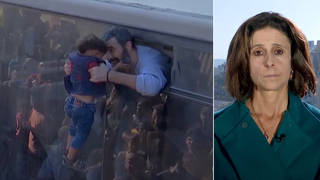
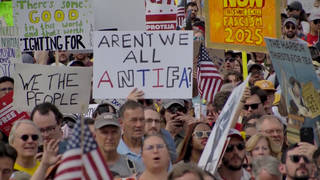
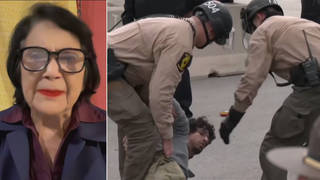





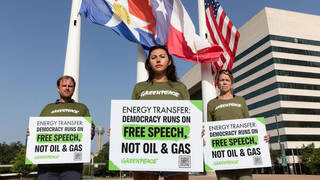
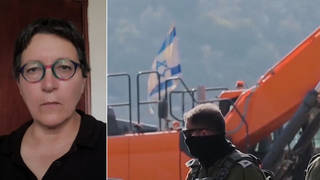
Media Options